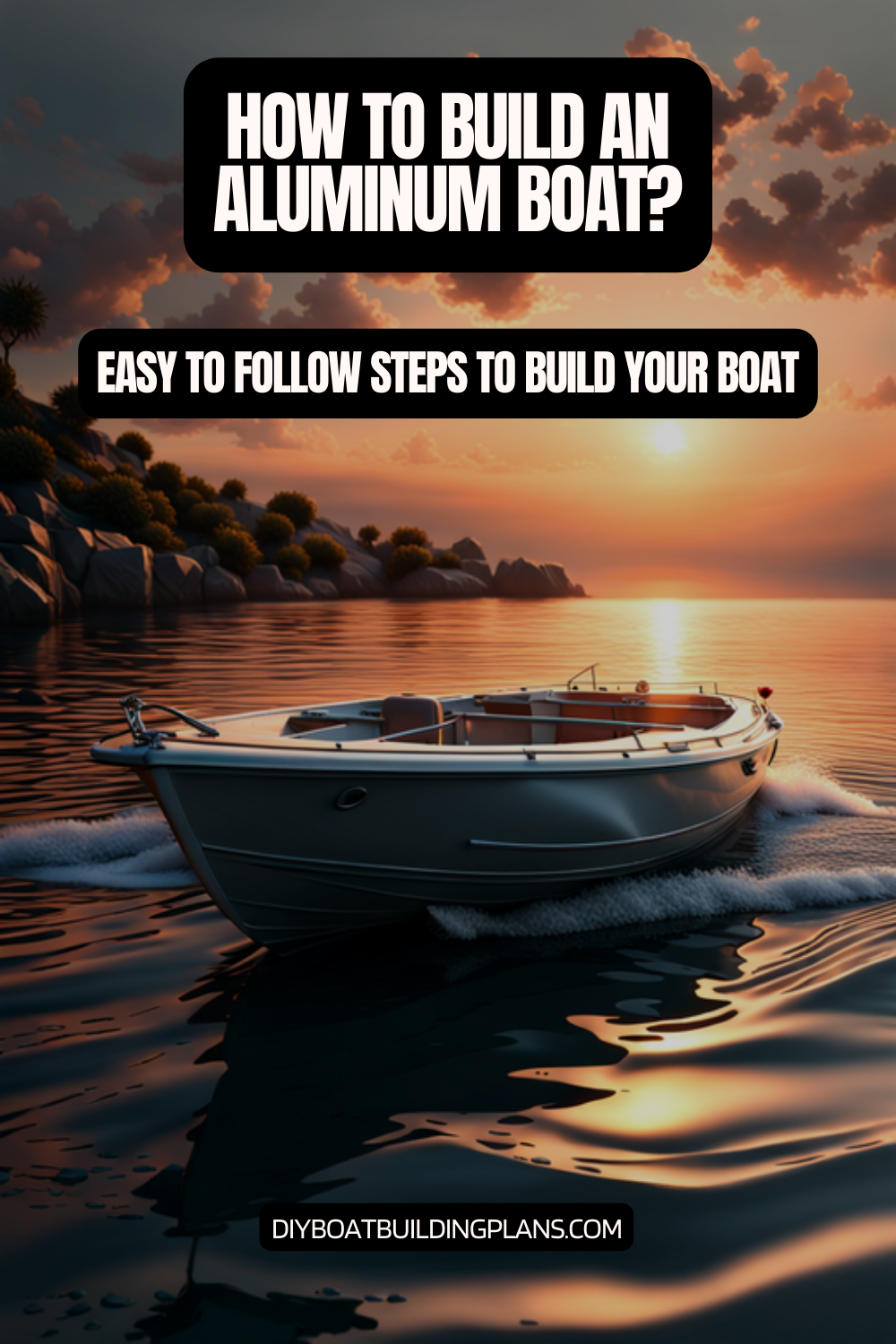Overview of How To Build an Aluminum Boat
Aluminum boats have gained immense popularity in recent years due to their numerous benefits. One of the key advantages of aluminum boats is their durability. Unlike traditional fiberglass boats, aluminum boats are resistant to corrosion, making them ideal for saltwater environments. Additionally, aluminum boats are lightweight yet sturdy, allowing for better fuel efficiency and maneuverability on the water.
There are various types of aluminum boats available in the market, each designed for specific purposes. One popular type is the Jon boat, which is a flat-bottomed boat commonly used for fishing in shallow waters. Another type is the pontoon boat, which features a flat deck supported by pontoons on either side, providing stability and ample space for recreational activities. Additionally, there are aluminum fishing boats, bass boats, and even larger vessels like yachts and commercial ships made from aluminum.
Key Takeaways
- Aluminum boats are lightweight, durable, and low-maintenance.
- Choosing the right aluminum alloy is crucial for the strength and corrosion resistance of your boat.
- Designing your boat requires careful consideration of factors such as size, shape, and intended use.
- Proper preparation of your workspace and tools is essential for safe and efficient boat building.
- Welding techniques such as TIG and MIG are commonly used for aluminum boat construction.

Choosing the Right Aluminum for Your Boat
When it comes to building an aluminum boat, it is crucial to choose the right grade of aluminum. Different grades of aluminum offer varying levels of strength and corrosion resistance. The most commonly used grades for boat building are 5052 and 5086 aluminum alloys. These alloys are known for their excellent corrosion resistance and high tensile strength.
Factors to consider when choosing aluminum for your boat include the intended use of the boat, the expected water conditions, and your budget. If you plan to use your boat in saltwater environments or rough waters, it is advisable to opt for a higher-grade aluminum alloy with superior corrosion resistance. On the other hand, if you are on a tight budget or plan to use your boat primarily in freshwater lakes or calm rivers, a lower-grade aluminum alloy may suffice.
Designing Your Aluminum Boat
Before starting the construction process, it is essential to create a blueprint or plan for your aluminum boat. This blueprint will serve as a guide throughout the building process and ensure that all components fit together seamlessly. When designing your boat, consider factors such as the intended use, the number of passengers it will accommodate, and any specific features or amenities you desire.
Choosing the right size and shape for your boat is also crucial. The size of your boat will depend on factors such as storage space, transportation limitations, and the number of passengers you plan to carry. Additionally, the shape of your boat will determine its stability and performance on the water. Factors such as hull design, bottom shape, and overall weight distribution should be taken into account when selecting the shape of your aluminum boat.
Preparing Your Workspace for Boat Building
| Workspace Preparation Metrics | Values |
|---|---|
| Workspace Size | 20ft x 20ft |
| Lighting | LED lights with 5000 lumens |
| Power Outlets | 6 outlets with 120V |
| Workbench Size | 8ft x 4ft |
| Storage Space | 4 shelves with 2ft x 4ft each |
| Tools Available | Table saw, jigsaw, drill press, hand tools |
Setting up a dedicated workspace is essential for efficient and safe boat building. Ideally, you should have a well-ventilated area with ample space to maneuver around the boat during construction. It is advisable to have a sturdy workbench or table where you can lay out and assemble various components of the boat.
In terms of tools and equipment, there are several essentials required for building an aluminum boat. These include a tape measure, a circular saw or jigsaw for cutting aluminum sheets, clamps for holding pieces together during welding, a welder for joining aluminum parts, and various hand tools such as hammers, screwdrivers, and wrenches. Safety equipment such as gloves, goggles, and a welding helmet should also be readily available to protect yourself during the construction process.
Cutting and Shaping Aluminum Sheets
Once you have set up your workspace and gathered the necessary tools, it is time to start cutting and shaping the aluminum sheets for your boat. Begin by measuring the dimensions specified in your blueprint and marking them on the aluminum sheets using a tape measure and marker. Ensure precise measurements to ensure accurate fitting of the sheets during assembly.
Next, use a circular saw or jigsaw with a fine-toothed blade to cut the aluminum sheets according to the marked measurements. Take your time and follow the lines carefully to achieve clean and accurate cuts. It is advisable to wear safety goggles and gloves during this process to protect yourself from any metal shavings or sharp edges.
After cutting the sheets, you will need to shape them to fit the design of your boat. This can be done using various techniques such as bending, rolling, or hammering the aluminum sheets. Depending on the complexity of your boat design, you may need to use specialized tools or seek professional assistance for shaping the sheets accurately.
Welding Techniques for Aluminum Boats
Welding is a crucial step in building an aluminum boat as it involves joining various components together to create a sturdy structure. There are different welding techniques that can be used for aluminum boat construction, including MIG (Metal Inert Gas) welding, TIG (Tungsten Inert Gas) welding, and stick welding.
MIG welding is the most commonly used technique for aluminum boat building due to its ease of use and versatility. It involves using a wire electrode that is continuously fed through a welding gun, creating an electric arc that melts the aluminum and forms a strong bond. TIG welding, on the other hand, requires more skill and precision but produces cleaner and higher-quality welds. Stick welding is another option but is less commonly used for aluminum boat construction.
Regardless of the welding technique chosen, it is crucial to follow proper safety precautions when working with aluminum. Aluminum can produce toxic fumes when heated, so adequate ventilation is essential. Additionally, wearing protective gear such as gloves, goggles, and a welding helmet is necessary to protect yourself from sparks and UV radiation emitted during the welding process.
Installing the Hull and Deck
Once the individual components of your aluminum boat have been cut, shaped, and welded together, it is time to install the hull and deck. The hull is the bottom part of the boat that comes into contact with the water, while the deck is the upper surface where passengers and cargo are located.
To attach the hull and deck to the boat frame, use clamps or temporary fasteners to hold them in place. Ensure that they are aligned correctly according to your blueprint and make any necessary adjustments before permanently securing them. Once aligned, use welding techniques to join the hull and deck to the boat frame, creating a strong and watertight bond.
After attaching the hull and deck, it is crucial to seal and waterproof the boat to prevent any leaks or water damage. This can be done using marine-grade sealants and adhesives specifically designed for aluminum boats. Apply these sealants along the joints and seams of the boat, ensuring a tight and secure seal.
Adding Structural Support and Reinforcement
To ensure the structural integrity of your aluminum boat, it is essential to add support beams and braces. These components provide additional strength and stability, especially when navigating rough waters or carrying heavy loads.
Support beams are typically installed along the length of the boat, running parallel to the hull and deck. They help distribute weight evenly and prevent flexing or bending of the boat’s structure. Braces, on the other hand, are installed diagonally between support beams to further reinforce the boat’s framework.
When adding structural support and reinforcement, it is crucial to follow your blueprint or plan carefully. Ensure that all components are securely welded or fastened in place to avoid any weak points in the boat’s structure. Additionally, consider factors such as weight distribution and balance when positioning support beams and braces to optimize the boat’s performance on the water.
Installing the Engine and Electrical Systems
Once the basic structure of your aluminum boat is complete, it is time to install the engine and electrical systems. Choosing the right engine for your boat depends on factors such as its intended use, size, weight, and power requirements.
Consult with a marine engine specialist or refer to the manufacturer’s guidelines to select an engine that is suitable for your boat. Consider factors such as horsepower, fuel efficiency, and compatibility with the boat’s design and intended use. It is also essential to ensure that the engine is properly installed and securely fastened to the boat’s transom.
In addition to the engine, installing electrical systems and wiring is crucial for powering various components of your aluminum boat. This includes navigation lights, bilge pumps, sound systems, and other electrical accessories. It is advisable to consult with an electrician or refer to marine electrical guidelines to ensure proper installation and adherence to safety standards.
Download over 500 Boat Plans. Click on the link below.
-->Click Here<--
Finishing Touches: Painting and Upholstery
With the major components of your aluminum boat in place, it is time to add the finishing touches that will enhance its appearance and comfort. Painting the boat not only adds aesthetic appeal but also provides an additional layer of protection against corrosion and UV damage.
Before painting, it is essential to prepare the surface by sanding it down and removing any imperfections or rough spots. Apply a primer specifically designed for aluminum surfaces to ensure proper adhesion of the paint. Once the primer has dried, apply multiple coats of marine-grade paint in your desired color or design.
In addition to painting, adding upholstery and finishing touches can greatly enhance the comfort and functionality of your aluminum boat. Install seats, cushions, and other upholstery according to your design preferences and intended use of the boat. Consider factors such as durability, water resistance, and ease of maintenance when selecting upholstery materials.
Testing and Launching Your Aluminum Boat
Before taking your newly built aluminum boat out on the water, it is crucial to thoroughly test it for safety and functionality. Conduct a series of tests to ensure that all components are working correctly and that there are no leaks or structural weaknesses.
Start by checking all electrical systems, including navigation lights, bilge pumps, and any other installed accessories. Test the engine to ensure proper starting, running, and steering functionality. Additionally, inspect the boat for any signs of leaks or water ingress, paying close attention to joints, seams, and areas where components are attached.
Once you are satisfied with the boat’s performance and safety, it is time to launch it into the water. Choose a suitable location such as a boat ramp or marina and follow all local regulations and guidelines for boat launching. Take your time and ensure that the boat is properly aligned and securely fastened before launching it into the water.

Conclusion – How To Build an Aluminum Boat
Building an aluminum boat can be a rewarding and fulfilling project for those with a passion for boating and craftsmanship. By following the steps outlined in this article, you can successfully construct your own aluminum boat, tailored to your specific needs and preferences.
From choosing the right aluminum grade to designing and constructing the boat’s structure, each step requires careful planning and attention to detail. By investing time and effort into each stage of the construction process, you can create a durable, functional, and aesthetically pleasing aluminum boat that will provide years of enjoyment on the water.
Remember to always prioritize safety throughout the construction process by wearing appropriate protective gear and following proper welding techniques. Additionally, consult with professionals or seek expert advice when needed to ensure that your boat meets all safety standards and regulations.
Building an aluminum boat is not only a practical endeavor but also an opportunity to unleash your creativity and craftsmanship. Embrace the challenge, enjoy the process, and soon you will be cruising on the water in a vessel that you built with your own hands.
FAQs – How To Build an Aluminum Boat
What materials are needed to build an aluminum boat?
To build an aluminum boat, you will need aluminum sheets, rivets, a rivet gun, a jigsaw, a drill, a saw, a file, a measuring tape, and a pencil.
What are the steps to build an aluminum boat?
The steps to build an aluminum boat include designing the boat, cutting the aluminum sheets to size, drilling holes in the sheets, riveting the sheets together, adding reinforcements, and finishing the boat with paint or sealant.
What are the benefits of building an aluminum boat?
Aluminum boats are lightweight, durable, and resistant to corrosion. They are also easy to maintain and repair, and can be customized to fit specific needs.
What are some common mistakes to avoid when building an aluminum boat?
Common mistakes to avoid when building an aluminum boat include using the wrong type of aluminum, not measuring accurately, not using enough rivets, and not reinforcing the boat properly.
How long does it take to build an aluminum boat?
The time it takes to build an aluminum boat depends on the size and complexity of the boat, as well as the skill level of the builder. A small, simple boat may take a few days to build, while a larger, more complex boat may take several weeks or months.
Can I build an aluminum boat without any prior experience?
While prior experience in boat building or metalworking can be helpful, it is possible to build an aluminum boat without any prior experience. However, it is important to do thorough research and follow instructions carefully to ensure a safe and successful build.



